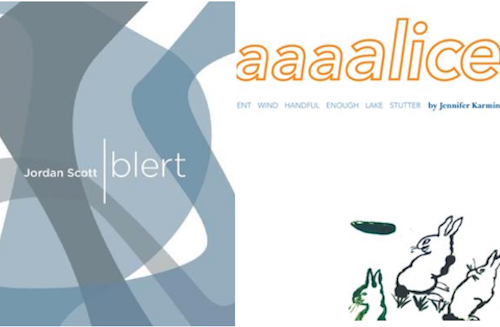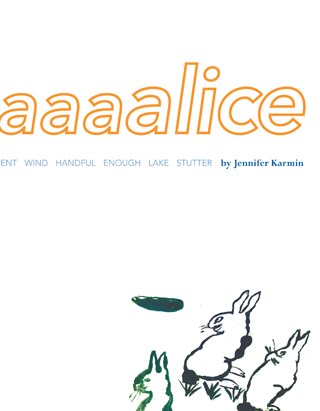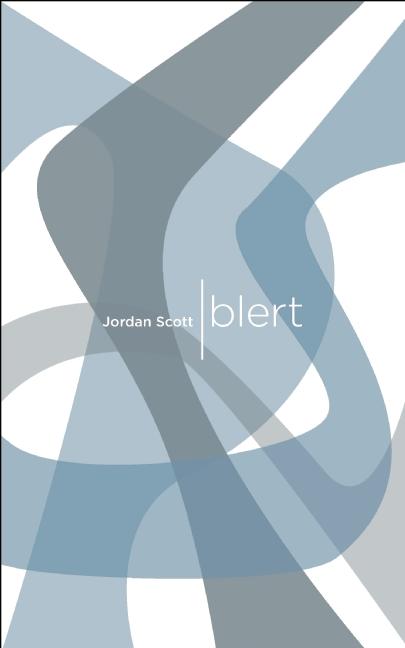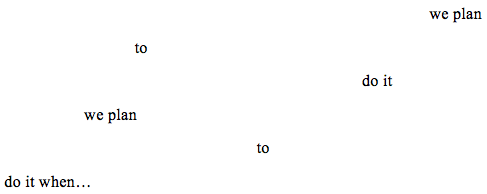
Although stuttering has a long history in the apocrypha of the West as an impediment serious enough to warrant correction (e.g., Demosthenes putting pebbles in his mouth to correct his speech and, more recently, Alvin Lucier’s experimental sound project “I Am Sitting In A Room,” layered recordings meant to reduce the artist’s stutter to an inaudible level), it has often served as a comic device in fiction (One Flew Over The Cuckoo’s Nest), film (A Fish Called Wanda), television (South Park) and popular music (Roy Orbison, The Who, Bachman-Turner-Over, Elton John, The Knack, Mystikal, etc.). But what about the use of stuttering in poetry? Consider the performance poetry of Detroit artist Semaj Brown (née James). As Semaj James, she recorded a number of poem-songs very much in the manner of Jayne Cortez, Amiri Baraka, and The Last Poets. One of these pieces, “Willie,” has the refrain “I do not stutter.” Because it is a refrain it gets repeated over and over, drawing attention to the phonetic, even phonemic, relation between repetition and stuttering. In the context of “Willie,” the line refers to a psychological “block” brought on by romantic/sexual desire; it is less a crisis of articulation than a whimsical ploy. In her 1997 chapbook, The Dancing Shoes On Fire, the relevant lines appear this way: “i begin to stutter/ and i do do not not stut ter.” Irony here is achieved by opposing morphemic repetition and syllabic fragmentation, two characteristics of stuttering, to the semantic value of the line. In this context one might also recall Norman Pritchard’s poem “Galax Gyre,” which, like many Black Arts poems, depends almost entirely upon repetition of entire lines of verse and blues- or jazz-inflected variations in tone that is “invisible” in its straightforward Standard English verbal score. Because Pritchard treats the alphabet like the keys on a piano, his use of the phoneme, singularly or multiplied, presupposes the mouth as simply a musical instrument, not an instrument of speech. In this case, Pritchard’s streaming, looping repetitions are the very opposite of the fragmented hesitations characteristic of stuttering.
However innovative in structure and form, both James’s and Pritchard’s works presuppose normative models of music and speech, though Pritchard’s points toward more radical possibilities realized in the recordings by poets like Tracie Morris and M. NourbeSe Philip. Lately, I have been reading and thinking about the poetry of Jordan Scott and Jennifer Karmin and the “problem” of the stutter, not only its psychosomatic facets (the focus of several reviews of Scott’s Blert) but also its social and cultural functionality. That is, what happens when the stutter becomes part of an aesthetic toolbox for poets with varying degrees of vocal “ability”? Unlike Scott, Karmin is not a stutterer, but she has written a poem titled “Stutter.” What does it mean for an able-bodied poet to employ a form of speech normatively considered a form of disability? And what of differently abled poets whose work evinces no “symptoms” of disability? Each of these questions hinges on the value assigned to difference per se, and difference—whether to embrace or eliminate—has become an important, vigorously debated, “value” within differently abled communities. This point was made again at a session at the 2017 Louisville Conference on Literature Since 1900. Poet Jennifer Bartlett, who has cerebral palsy but whose work rarely, if ever, “refers” to, much less, “displays,” its effects on her body, reminded the audience of the ablest assumptions underlying visual and oral presentations at academic conferences since no one was “translating” the speech of plenary speaker James Smethurst into sign language.
It would be presumptuous to infer from Bartlett’s comments that we are all differently abled (the ostensible assumption of comedy) without this important proviso: the “professionalized” arts, which include the poetry business of publications, readings, and reviews, privilege certain abilities over others. I’m old enough to remember the student rebellion at Gallaudet over the hiring of a hearing president and, before that, the assault on the hegemony of hearing and speaking by deaf activists who did not want to be “cured” or “fixed.” Although these criticisms of “competence” remain largely within deaf activist circles, their implications for, say, the popularity of oral and performance oriented poetries in the United States since the 1950s are significant. As the somatic poetics of poets as different from one another as CAConrad, Cathy Wagner, and Julie Patton suggest, a somatic-based poetics other than the norms channeled through the mouth, ear, and eye—that is, one based on skin and orifices, on touch, taste, and smell (in the latter case I’m thinking of the arrested Perfume Recordist collaboration between the late Stacy Doris and Lisa Robertson)—serves to criticize by example the traditional concepts of the poet as shaman and/or prophet. This remains true not despite but because Conrad, Wagner, and Patton read (and in Wagner’s and Patton’s cases, sometimes sing) their poems. All three, in different ways, draw attention to the facticity of their bodies as matrices for their poems, undermining the metaphysics of “inspiration.” However, in reading and performing their poems without particular attention to their bodies—that is, in reading and performing poetry like most traditional page-based poets—all three reinforce the metaphysics of the traditional poetry reading where everyone pretends that the only thing that matters is the “voice” or “language” of the performing poet, his or her attire, posture and physical appearance in abeyance.
Of course, one could say that the body functions for these women and this man the way the n-word serves for some black people: what was used against us is reclaimed and repurposed in defiance of its origin. If first wave feminism had to insist on cognitive equivalences between men and women (and thus implicitly acknowledge and demote biological differences), subsequent waves of feminists have reclaimed and indeed celebrated the biological (and cultural, social and political) differences of bodies. With important differences noted between the histories of Western feminism and sexual orientation, similar phases punctuate the history of pre- and post-Stonewall gay activism. These social, cultural and political movements have imprinted recent developments within the academy, the Louisville conference notwithstanding. The return of affective modes of literary and cultural criticism in the last thirty years or so has served to put the body, male and female, back on stage. Yet the traditional poetry reading is so entrenched within the poetry business that the body remains in the background even among performance-, spoken-word- and somatic-based poets.
The Platonism underlying the normative poetry reading has its analog in the book reviewing process. The relationship between book design (including cover art, font, and paper) and poems is rarely discussed in most reviews of poetry books. One would think this tendency would be less prominent in reviews of chapbooks, which often draw attention to their artisan/art histories, but sadly this is not the case. None of this is criticism, of course, and one might easily dismiss these observations as a naiveté uninformed by, for example, the histories of industrialism and the attendant divisions of labor. Thus, one might point out that graphic designers have their own journals and reviews that marginalize “content,” in order to discuss, review, and criticize various tendencies and norms regarding design and form. In short, since most reviewers of books of poetry are themselves poets or consistent readers of poetry, it is hardly surprising that the physical or digital book is so much giftwrap paper, an envelope to be ripped open and tossed aside in order to get to the poems themselves. Still, from the point of view of somatic-based practices, one might expect a more complex engagement between the “body” of the poems (the design and form of the book) and the “body” of the poet. However, it has been my (admittedly limited) experience that poets who do engage the form of the book (Julie Patton, Brenda Iijima, and C.J. Martin, for example) do not (with the exception of Patton) practice, or at least foreground, somatic-based poetics in their work.
Poets have instead preferred to work from the inside out, to engage the body of the poem—e.g., format, lay-out—on the page. Given the long history associated with this practice—e.g., from the earliest days of imperial China to the internationalism of the avant-garde (Soviet Union, Spain, Brazil, South Africa, etc.), to say nothing of recent developments in concrete, vispo and asemic poetry—the poets who work in this tradition can only rework its basic strategies. It is in this context that the poetry of Jordan Scott and Jennifer Karmin interests me. Specifically, I am interested in the ways that the “problem” of stuttering, of the stutter, arises in Scott’s and Karmin’s poems. For even during the most conventional poetry reading, stuttering draws attention to the body. But I want to start with the stutter as less a physiological response of the body to anxiety, for example, than an aestheticized object deployed by a poet who does not, as far as I know, stutter.

In her 2010 book, aaaaaaaaaaalice (flim forum press), Karmin summons the spirits of Lewis Carroll’s 1865 novel Alice’s Adventures in Wonderland, a Japanese language acquisition textbook, and the 1974 anthology of Asian American writers titled AIIIEEEEEE! While Karmin herself has acknowledged her debt to Lewis Carroll—the verso pages quote from Carroll’s story while the recto pages mimic the linguistic structures of language instructional texts—the allusion to the Asian American anthology, whose title captures and plays with one stereotype, may seem a stretch. However, insofar as Karmin’s book has been understood as a variation on the travelogue, and for at least one critic, a travelogue in tense relationship to the epic, the isomorphic relationship it establishes between itself as a genre and stereotype—travels through the East (China, Taiwan, Mongolia, etc.) as observed and recorded by a Westerner—suggests that this book undermines the grandiosity of the epic and deconstructs the aesthetic/ethical negativities associated with travel writing. And while Erika Jo Brown opens her brief review of the book by highlighting its unusual design (e.g., the Table of Contents is spread across the cover beneath the title), she does not pay much attention to the way Karmin interweaves passages from the Carroll novel with language acquisition methodologies. However logically linked to preceding sections, “Stutter,” the last section, veers formally and, to a certain extent, thematically, from the rest of the book. Unlike the first ten sections that obey a formal rigor (stanzas on the verso, field writing on the recto, pages), this eleventh section undermines the integrity of the procedures: stanzaic verses appear separately on both verso and recto pages, as field writing bleeds across. The overall effect is a reduction of the procedural rules that defined the bulk of the book, an interchange of positions apparently reinforced by the last, repeated line of the poem: “we’ve reached the point where we understand a little.” That phrase “a little” undermines the possibility of mastery, and in this way presumably plays against the stereotype of the travelogue that attempts total understanding. While one could take issue with the presumptions regarding the stereotype of the travelogue, I want to focus on the ways that “stutter” is imagined here. Unlike the book’s title which mimics the phonic structures of stuttering while simultaneously undermining the possibility of its being written in an alphabetic script (like the stereotype aaaaiiiieeee, the repetition of vowels indicates elongation, not failed enunciation), the stutter here is mere repetition of words and phrases. One response to this comment might be that Karmin, as we will see in Scott, is not trying to represent, much less, “show” the stutter. Instead, she thematizes the blockage to enunciation. She does indeed do this, but in this book stutter describes not the problem of language acquisition per se (as in Scott’s work) but rather the problem of cross-cultural mastery: “frustration/grasping with language/living seeing knowing/not able to obtain//myths we create.” The first verse in “Stutter” has the same form as the other verso verses in previous sections of the book; a Carroll quotation severed by the stanzas serves as both title (“and what is the use”) and coda (“without /pictures or/conversations”). Of course, Alice in Wonderland skewers the humanist myth that “picture or/ conversations” help us “understand a little.” In fact, it teaches us the opposite: nothing is a buffer, much less a guarantee, against misunderstanding. In brief, to reference Alexander Pope’s “A little knowledge is a dangerous thing,” “a little” here might be read against the possibility of some intra- or inter-cultural understanding.

Conventionally, the stutterer is one for whom speech can shift unexpectedly from unself-conscious to self-conscious motor operations. This momentary loss of control, of agency, is formally depicted in Jordan Scott’s Blert (2004) and, to a lesser degree, in night & ox (2016). For Scott, pronouns are the infrequent signifiers of selfhood; the body—specifically, the mouth as a physical structure—is a vessel in which blocks of phonemes are churned before being rolled out as complete—or ejected as partial—morphemes. As reviewers of Blert have pointed out, the difficulty of reading Scott’s text is not due to his rather common use of parataxis but rather its scientific-cum-phonetic lexicon (anatomical, botanical, geographical, etc.), its Joycean neologisms, and its emphasis on the mechanics of pronunciation. Though normative spelling, syntax, and pronunciation are not entirely jettisoned, the general reader is forced to navigate a wordscape that puts him or her in a linguistic environment analogous to that of the stutterer.
Yet, for all the apparent differences between Scott and Karmin, there are passages in Blert that echo those in aaaaaaaaaaalice! I’m thinking in particular of the language acquisition model. Here’s Scott’s version:
Some will not when by themselves.
Some will not when speaking to children or animals.
Some will not when they sing.
The writing of the recto pages of Karmin’s book end in stanzaic forms (e.g., “we/plan/ to do it/in the future”) but begin in field variations:

As I noted earlier, Karmin sticks to this basic strategy on all the recto pages until the final section, “Stutter.” There, blockage to speech, to language, is indicated not only by repetition and variation but also, for the first time in the book, different fonts and typeface size, a nod to those moments in Carroll’s novel when Alice’s body expands after she consumes cake and mushrooms. Karmin’s more conventional use of scale (i.e., language acquisition expands our horizons) marks a typographical limit Scott supersedes by a phonetic writing that more closely approximates the actual sounds he hears himself saying. However, the fact that Scott struggles toward the norms of articulation is already an indication of his general refusal to remain within the world of the idiolect. Blert is the record of a private language only if one understands that public languages fuel such a language. These accessible languages serve as scaffolds on which Scott builds word “chomps” (as Craig Dworkin calls them). And though Scott demands (himself? us? both?) to “masticate/ equation” since word order = world ardour,” Blert does not, in general, violate the rules of grammar and syntax. However, Scott does wrestle with the social, cultural, economic and, especially, ecological consequences of making sense, a struggle detailed in Decomp, his collaboration with Stephen Collis, and, most recently, in night & ox. In the latter, normative grammar, syntax and word usage flash up from the streams of perception (a la Tom Raworth) only when Scott refers to himself in the first person singular. And these moments are almost always associated with the interpellation of the subject—“I’m/ leaving/ for/ work”—and the impossibility of complete absorption: “I/can only think//in threshold/oolican greasevoice.” Unable, and (thus?) unwilling, to escape the materiality of his mouth, blocked from the self-affirming, seamless presence, of an unselfconscious “voice,” Scott is not easily absorbed into the abstractions of capital.
The above might imply that Karmin’s relative “normal” body and normative verse block her from accessing what it’s “really” like to imaginatively represent via “poetics,” much less empathetically inhabit, a body deemed disabled. This well-rehearsed line of thinking leads inexorably to the predictable, if “correct,” positions on the Dana Schutz, Kenneth Goldsmith, and Rachel Dolezal controversies: white representations of black bodies “analogous” to ableist depictions of disabilities. Here, I am less interested in pursuing these important, difficult questions than I am in bringing together what I might call, crudely, inside and outside perspectives on a common speech impediment. More important, as I suggested at the outset, I’m interested in what it means to use a so-called “defect” for aesthetic purposes. For example, does Scott risk self-exoticism to the extent Blert might suggest to non-stutterers that all stuttering sounds the same from the inside, even though Scott has been clear that the idiolect on view in his book cannot be abstracted as a general score from which others might perform? Karmin’s use of cross-cultural language acquisition difficulties as approximating, if not equal to, stuttering within a language is less risky because more transparent. No reader could confuse these depictions of different motor and psychosomatic operations. Understood this way, Karmin’s “understand a little” would not exclude but, in fact, incorporate Pope’s “A little knowledge is a dangerous thing,” especially when one recalls that the verso stanzas constitute a travelogue, the genre of surface reading par excellence. On the other hand, the difficulty of Blert might tempt one to conflate its obstacles to normative reading habits with authentic—that is, a unique inimitable—minority experience: this is how “genuine” stuttering looks and sounds. As night & ox suggests, however, Jordan Scott the poet cannot be conflated with Jordan Scott the English-speaking citizen of Canada. And as I noted at the beginning of this essay, the same can be said for Jennifer Bartlett; the woman who has cerebral palsy cannot be conflated with the poet.
But what about their bodies? To what extent do they, like most poets, take their bodies for granted? Or (and?) to what extent do they refuse to do so, and how are their bodies read at, for example, poetry readings or academic conferences? Do they care? Should they? Should we?
Poet Tyrone Williams was born in Detroit, Michigan and earned his BA, MA, and PhD at Wayne State University...
Read Full Biography

